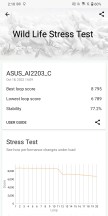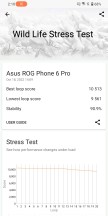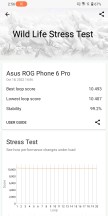Three Asus ROG Phone 6 models put to test - which one is the fastest?

Introduction
We've recently reviewed both the ROG Phone 6 Pro and the ROG Phone 6D Ultimate. As you might already know, the former of the two is based around Qualcomm's Snapdragon 8+ Gen 1 chipset, while the latter uses a tuned version of MediaTek's Dimensity 9000+ chipset. The ROG Phone 6D Ultimate also has the unique Asus AeroActive Portal on its back - an active air duct with thin thermal fins and a direct pathway into the internal cooling of the phone. It is an intriguing piece of hardware that we already tested in our 6D Ultimate review.

Today, we turn our attention to the vanilla ROG Phone 6D - the non-Ultimate model. Just like its 6D Ultimate sibling, it is based on the Dimensity 9000+ chipset. Unlike it, however, it lacks the AeroActive portal, which means that, at the very least, there are some thermal management differences between the two. Since this and the absence of a ROG Vision display on the back of the ROG Phone 6D are the only differences to note between the vanilla and the Ultimate, we won't be doing a full review. It would be very redundant, to say the least. What we will be doing, however, is benchmarking the ROG Phone 6D and testing its thermal throttling behavior to see how it compares to its sibling, which would answer the question of which is the best-performing ROG Phone 6.
Synthetic benchmarks
Before we get into benchmark numbers, some additional info is in order. The ROG Phone 6D unit we have for testing is the special Batman edition. Just like its Ultimate sibling, it has an essentially overclocked MediaTek Dimensity 9000+ chipset. Users get a single primary Cortex-X2 core, clocked at up to 3.35 GHz instead of the default 3.2 GHz. The three Cortex-A710 cores are also overclocked to 3.20 GHz instead of their default 2.85 GHz. The remaining four "small" Cortex-A510 cores are left at their default 1.8 GHz, which makes sense seeing how they are meant for efficiency instead of performance.

In terms of GPU, the ROG Phone 6D and 6D Ultimate are both rocking the Mali-G710 MC10 with no mention of an overclock of any sort. The chipset is paired with 256GB of UFS 3.1 storage and up to 16GB of RAM, which sounds kind of strange at first, given the ROG Phone 6 Pro offers up to 18GB of RAM. However, the ROG Phone 6D and 6D Ultimate use the newer LPDDR5X RAM, which currently only goes to 16GB modules, which explains the decision. Our particular Batman unit, however, is not the highest-tier model, so it has 12GB of RAM at its disposal.
We'll be the first to admit that benchmark scores from the ROG Phone 6D are predictable, but we won't hear us complain about consistency compared to the ROG Phone 6D Ultimate.
CPU performance from the MediaTek Dimensity 9000+ is clearly better than the Snapdragon 8+ Gen 1 inside the ROG Phone 6 Pro - especially in the multi-core test, where the former got more than 30% higher performance in the default Dynamic mode.
In the single-core part of the test, the ROG Phone 6 Pro took the lead until X-Mode was activated. Obviously, Asus has managed to tune the X-Mode on the Dimensity 9000+ very well.
GeekBench 5 (multi-core)
Higher is better
-
ROG Phone 6D (X Mode+)
4631 -
ROG Phone 6D (X Mode)
4586 -
ROG Phone 6D Ultimate (X Mode+)
4575 -
ROG Phone 6D Ultimate (X Mode)
4528 -
Asus ROG Phone 6 Pro (X Mode+)
3980 -
Asus ROG Phone 6 Pro (X Mode)
3889 -
ROG Phone 6D
3531 -
ROG Phone 6D Ultimate
3505 -
Asus ROG Phone 6 Pro
2659
GeekBench 5 (single-core)
Higher is better
-
ROG Phone 6D (X Mode)
1402 -
ROG Phone 6D (X Mode+)
1399 -
ROG Phone 6D Ultimate (X Mode)
1374 -
ROG Phone 6D Ultimate (X Mode+)
1360 -
Asus ROG Phone 6 Pro (X Mode+)
1329 -
Asus ROG Phone 6 Pro (X Mode)
1300 -
Asus ROG Phone 6 Pro
1110 -
ROG Phone 6D
1015 -
ROG Phone 6D Ultimate
1001
AnTuTu seems to offer a bit more of a "spread" in scores at first glance, but once you get down to it, the variances are still well within the margin of error from run to run, and the ROG Phone 6D and 6D Ultimate trade blows in the three different modes. The ROG Phone 6 scores surprisingly low in the default Dynamic mode but gains back its stand once X Mode is engaged.
Apparently, the 12GB of RAM in the ROG Phone 6D did not prove to be a major disadvantage in AnTuTu.
AnTuTu 9
Higher is better
-
ROG Phone 6D Ultimate (X Mode+)
1107464 -
ROG Phone 6D (X Mode+)
1104042 -
Asus ROG Phone 6 Pro (X Mode+)
1103188 -
Asus ROG Phone 6 Pro (X Mode)
1094300 -
ROG Phone 6D (X Mode)
1089220 -
ROG Phone 6D Ultimate (X Mode)
1085829 -
ROG Phone 6D
948594 -
ROG Phone 6D Ultimate
931170 -
Asus ROG Phone 6 Pro
762090
Moving on to graphical benchmarks, we find another batch of consistently similar scores. Again, the ROG Phone 6 scores at the bottom of both GFX Aztek tests but it gets back on track as soon as X Mode is activated.
GFX Aztek ES 3.1 High (onscreen)
Higher is better
-
ROG Phone 6D Ultimate (X Mode+)
63 -
ROG Phone 6D Ultimate (X Mode)
62 -
ROG Phone 6D (X Mode)
62 -
ROG Phone 6D (X Mode+)
62 -
Asus ROG Phone 6 Pro (X Mode)
61 -
Asus ROG Phone 6 Pro (X Mode+)
61 -
ROG Phone 6D
61 -
ROG Phone 6D Ultimate
59 -
Asus ROG Phone 6 Pro
58
GFX Aztek Vulkan High (onscreen)
Higher is better
-
Asus ROG Phone 6 Pro (X Mode+)
66 -
Asus ROG Phone 6 Pro (X Mode)
65 -
ROG Phone 6D Ultimate (X Mode)
64 -
ROG Phone 6D Ultimate (X Mode+)
64 -
ROG Phone 6D
64 -
ROG Phone 6D (X Mode+)
64 -
ROG Phone 6D Ultimate
63 -
ROG Phone 6D (X Mode)
63 -
Asus ROG Phone 6 Pro
56
As we move lower in the benchmark stack, we get to less difficult tests that use older graphical API versions. It's here that we notice that the Snapdragon 8+ Gen 1-powered ROG Phone 6 Pro scores higher than its MediaTek siblings.
The differences are hardly significant, but it does seem like Qualcomm's chip is better optimized for older OpenGL ES versions, for what that's worth.
GFX Car Chase ES 3.1 (onscreen)
Higher is better
-
Asus ROG Phone 6 Pro
79 -
Asus ROG Phone 6 Pro (X Mode)
79 -
Asus ROG Phone 6 Pro (X Mode+)
79 -
ROG Phone 6D (X Mode)
77 -
ROG Phone 6D (X Mode+)
76 -
ROG Phone 6D Ultimate
72 -
ROG Phone 6D Ultimate (X Mode)
72 -
ROG Phone 6D Ultimate (X Mode+)
72 -
ROG Phone 6D
71
GFX Manhattan ES 3.1 (onscreen)
Higher is better
-
Asus ROG Phone 6 Pro (X Mode+)
140 -
Asus ROG Phone 6 Pro (X Mode)
139 -
Asus ROG Phone 6 Pro
126 -
ROG Phone 6D Ultimate (X Mode)
124 -
ROG Phone 6D Ultimate (X Mode+)
124 -
ROG Phone 6D (X Mode)
124 -
ROG Phone 6D (X Mode+)
123 -
ROG Phone 6D Ultimate
122 -
ROG Phone 6D
122
In any case, we are quickly starting to get numbers well in excess of 100 fps, which is hard to complain about in these synthetic and unrealistically difficult loads. Any modern game engine will be a lot more flexible when it comes to its rendering to ensure high frame rates.
Plus, it hardly comes as a surprise that what are arguably some of, if not the best, gaming phones currently around can render a lot of frames and chew through practically any task you throw at them.
Finally, the 3DMark Wild Life Extreme test paints the same picture as the last two tests - giving the nod to the Snapdragon 8+ Gen 1.
3DMark Wild Life Extreme (offscreen 1440p)
Higher is better
-
Asus ROG Phone 6 Pro (X Mode+)
2815 -
Asus ROG Phone 6 Pro (X Mode)
2814 -
ROG Phone 6D Ultimate (X Mode+)
2668 -
ROG Phone 6D Ultimate (X Mode)
2634 -
ROG Phone 6D (X Mode+)
2622 -
ROG Phone 6D (X Mode)
2621 -
Asus ROG Phone 6 Pro
2611 -
ROG Phone 6D Ultimate
2599 -
ROG Phone 6D
2555
Overall, the two MediaTek Dimensity 9000+ phones - the ROG Phone 6D and 6D Ultimate - snatch the victory in the performance section of the test. Asus and Mediatek have done a great job tuning the MediaTek chipset. The ROG Phone 6D is no slouch even though it's got 'only' 12GB of RAM. We'll be keeping an eye on it in the thermal-throttling section of our test to see if it can hold up as well as the 6D Ultimate and its AeroActive Portal.
Thermal-throttling behavior
In the second part of our test, we're taking a look at the thermal throttling behavior of the three ROG 6 phones during an hour-long run of the aptly named CPU Throttling benchmark as well as a 20min run of 3D Mark's Wild Life Extreme test, which is more GPU-intensive as it loops Vulkan 1.1-based 3D tests offscreen with a resolution of 1440p.
Going into the test, we expected the ROG Phone 6 Pro to run the coolest with its Snapdragon 8+ Gen 1 chipset.
The 6D Ultimate AeroActive Portal only activates once you attach the AeroActive cooler on the back of the phone, which is also when you are allowed to activate the X Mode+ mode.
So in the default Dynamic mode and in the lower X Mode, we expected the two 6D phones to perform similarly.
Dynamic mode
We start with the ROG Phone 6D in the default Dynamic mode. The vanilla 6D exhibited the smallest performance throttling of the three phones, but the other two started with much higher peak performance numbers - with the 6 Pro leading the pack. This behavior leads to the 6 Pro and 6D Ultimate having lower average performance than the 6D over the 1h test runtime.
As you see, the 6D and 6D Ultimate seem to be tuned differently. We're also witnessing a surprising variation from what we saw in the CPU-bound Geekbench result, where the two 6D phones scored identically.



Dynamic Mode: ROG Phone 6D • ROG Phone 6D Ultimate • ROG Phone 6 Pro
The 3DMark test paints the same picture, although there is much less difference in the performance. The ROG Phone 6 Pro leads the pack in 3DMark's test regardless of the performance mode.



Dynamic Mode: ROG Phone 6D • ROG Phone 6D Ultimate • ROG Phone 6 Pro
X Mode without the AeroActive Cooler attached
Moving on to X Mode without the AeroActive cooler attached.
Here, we see another great performance from the vanilla ROG Phone 6D. It even had the highest peak performance of the three phones in the CPU Throttling test.
The winner with X Mode ON, however, was the ROG Phone 6 Pro scoring the highest Average score and the highest Minimum performance score in the CPU Throttling test. It also had the highest score in the 3D Mark and the least throttling among the three devices.
The ROG 6 Ultimate had the largest dip in performance and a much more jagged performance line. Probably not jagged enough to really be felt as stuttering in real life, but it is still a notably different behavior from the other two phones.



X Mode w/o the cooler: ROG Phone 6D • ROG Phone 6D Ultimate • ROG Phone 6 Pro



X Mode w/o the cooler: ROG Phone 6D • ROG Phone 6D Ultimate • ROG Phone 6 Pro
X Mode+ with the AeroActive Cooler 6 attached
Finally, we have to look at the ROG Phones in their top performance state - X Mode+ with an attached AeroActive Cooler 6 going at full blast, which Asus calls "Frozen" mode. This is meant to give the chipset and the cooling setup the best chance to impress.
The winner here is yet again the ROG Phone 6 Pro with the highest scores across the board - its max, avg, and min scores are better than what the 6D Ultimate could muster, it's also the top device in 3D Mark's stress test.
The ROG Phone 6D Ultimate scores the lowest though the margin is not as large as in the previous test in X Mode. Overall, it's a solid showing, but we are a bit surprised it couldn't beat the vanilla 6D despite the built-in AeroActive Portal, which should improve the cooling in theory.
The ROG Phone 6D definitely does well in this round of testing. It didn't have the top peak performance in the CPU Throttling test (by a really small margin), but it bested the 6D Ultimate with its average and minimum scores, which are the ones that matter in a thermal-throttling test like this one.



X Mode+ w/ the cooler: ROG Phone 6D • ROG Phone 6D Ultimate • ROG Phone 6 Pro
The ROG Phone 6D also performed identically to the 6D Ultimate in the 3D Mark stress test - both in terms of scores, as well as in stability even though it lacks the Aeroactive Portal of the more expensive model.



X Mode+ w/ the cooler: ROG Phone 6D • ROG Phone 6D Ultimate • ROG Phone 6 Pro
Conclusion
In performance benchmarks, the ROG Phone 6D proved to have identical performance to the ROG Phone 6D Ultimate. After all, both phones share virtually the same hardware, with the Asus-tuned MediaTek Dimensity 9000+ chipset at the helm.
They also have better benchmark scores than the ROG Phone 6 Pro, except for the older OpenGL benchmarks, where the Snapdragon 8+ Gen 1 takes back its lead.

But maybe the biggest surprise in this comparative test was that when it comes to thermal throttling behavior, the vanilla 6D performed better or equally good as the ROG Phone 6D Ultimate in all three performance modes. Not only that, but it held its own against the 6 Pro.
However, it seems that the Mediatek chips are more prone to heating than the Snapdragon 8+ Gen 1 when pushed harder as the Snapdragon chipset kept its cool in the GPU Stress test.
Verdict
As we reach the end of this comparative test, it's time to come up with a verdict. If we had to choose a single device out of the three, we'd recommend getting the vanilla ROG Phone 6D. It only comes in 12GB/256GB configuration but we didn't find the 12GB RAM to be a bottleneck in any of the benchmarks. It also doesn't have a screen on its back, but the ROG Phone 6 Pro and 6D Ultimate will cost you about 30% more without providing any meaningful increase in performance.
The two 6D models are still on pre-order, but if you are not in a hurry with your purchase, we'd say the ROG Phone 6D is the cheapest and most sensible entry in the ROG Phone 6 series.
Related
Reader comments
- Hemedans
- 30 Oct 2022
- CAF
Issue with Arm isnt just talking Qualcomm to Court, its rumor which circulate that they want to licence Oem separately, Currently Oem they licence via chipmakers, Qualcomm, Mediatek, Exynos etc pay Arm and Oem pay these chipmakers. By licencing direc...
- Kangal
- 30 Oct 2022
- vJt
There is actually a HUGE difference in efficiency between TSMC and Samsung nodes. That's why I deleted my previous comment, to exclude the A76 from the Tensor 1 (Samsung). But on the bottom of that comment I said I could extrapolate their scores...








 Huawei
Huawei Samsung
Samsung Samsung
Samsung Apple
Apple Xiaomi
Xiaomi


